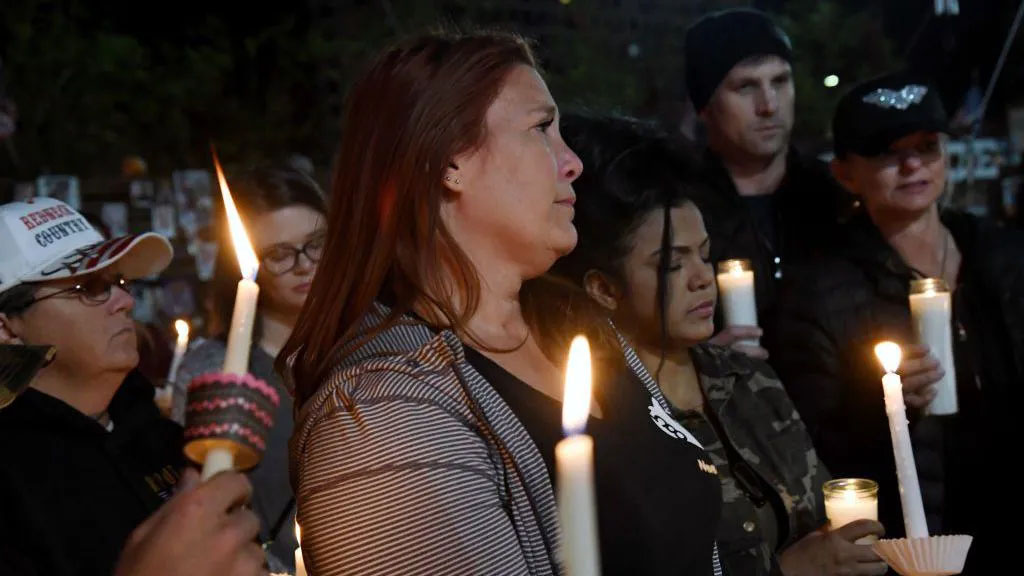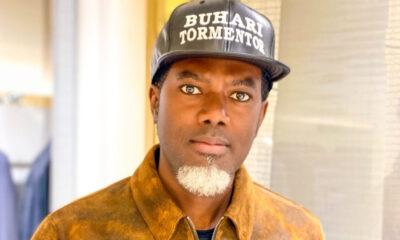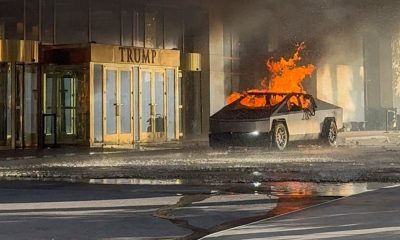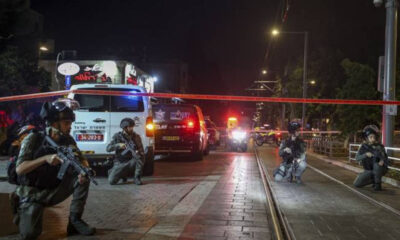International
Supreme Court gun ruling stuns Las Vegas shooting survivors

Supreme Court gun ruling stuns Las Vegas shooting survivors
On 1 October 2017, Heather Gooze was serving drinks at the Route 91 music festival in Las Vegas when concert-goers began running into her bar, screaming and covered in blood.
A gunman perched high in a Las Vegas hotel had opened fire on the festivities below. He killed 60 people and wounded over 400 more. He was able to carry out what is still the deadliest mass shooting in US history because of a mechanism he installed on his gun known as a bump stock.
In the aftermath of the massacre, then-President Donald Trump banned bump stocks, a modification that allows a rifle to fire like a machine gun. It was a rare example of the US making a change to its gun policies in the wake of a mass shooting, and it was a reform that survivors of the attack welcomed.
The ban was all the more extraordinary because it was instituted by a Republican president and supported by the National Rifle Association, figures that would normally oppose a gun control proposal.
On Friday, the US Supreme Court struck down the ban, deciding in a 6-3 opinion that the Bureau of Alcohol, Tobacco, Firearms and Explosives had overstepped its authority to outlaw the device.
For survivors like Ms Gooze, who identifies as liberal and thought Trump’s ban was “phenomenal”, the ruling felt like a step backward for the country.
“Who has ever used a bump stock for good?” she told the BBC. “There’s no reason for a civilian to use a mass shooting machine.”
Ms Gooze, 50, still vividly remembers the panic of helping people flee the carnage, and the frantic battle to save the people struck by the more than 1,000 rounds that the gunman fired with the help of his weapon’s modification.
“I had my finger in the bullet hole of one of our angels in the back of their head,” she said of one victim she tried to save. She stayed with the body of another victim for hours, using a phone she found in their pocket to contact the family.
“I watched people’s lives change right in front of my face, as well as my own,” she said.
One of those lives was Brittany Quintero’s. Ms Quintero was separated from her friend in the chaos of the shooting, and though they both survived, she has spent years working through the trauma the shooting inflicted.
READ ALSO:
- Tinubu’s June 12 fall: Humour, karma, compassion, By Farooq Kperogi
- Minimum wage: New law to sanction defaulting states coming – Senate
- FG bows to pressure, reconstitutes governing boards of 111 tertiary institutions
She told the BBC that the Supreme Court’s decision had left her reeling.
“It feels like another slap in the face, to be honest,” she said.
Ms Quintero, 41, said she does not necessarily believe that more stringent gun restrictions would help prevent mass shootings. She also believes not enough proposed solutions address mental health.
“I don’t think taking away people’s Second Amendment rights is going to solve these things that keep occurring,” she said, referring to the protections for gun owners enshrined in the US Constitution.
“If someone has it in their mind to do it, they’re going to find a way or other means.”
But despite her reservations, she still thinks the Supreme Court was wrong to reinstate access to bump stocks.
The Route 91 survivors were not universally disheartened by the Supreme Court decision. Several were discussing the news in a private Facebook group, Ms Gooze said, and some members of the community had responded that the ruling did not bother them.
“A gun isn’t the issue, we need them to keep what little freedom we have left. It’s the government that’s the enemy,” one survivor wrote in a message that Ms Gooze read to the BBC.
Gun violence remains a major public safety issue in the United States. The nation has experienced 215 mass shootings so far in 2024, according to the Gun Violence Archive (their methodology defines a mass shooting as when four or more people are shot or killed, not including the shooter).
Both Ms Gooze and Ms Quintero lamented that the gun debate had grown so politicised.
“I don’t think I’m ever going to see in my lifetime a true law or decision that will be made to solve the gun violence issue,” Ms Gooze said.
Repeated attempts to ban bump stocks through federal legislation have stalled, and face little chance of passing in the near term due to a divided Congress.
Trump, who is again running for president, said he would respect the Supreme Court’s decision to strike down his policy and reaffirmed his support for broader access to guns.
“The Court has spoken and their decision should be respected,” Trump campaign spokeswoman Karoline Leavitt said in a statement. “President Trump has been and always will be a fierce defender of Americans’ Second Amendment rights and he is proud to be endorsed by the NRA.”
In video on X, formerly Twitter, the gun shop owner who challenged the bump stock ban at the Supreme Court celebrated his victory and said he had prevented the government from banning other gun parts.
The nation’s highest court sided with his argument that the Trump administration overstepped when it sought to regulate bump stocks like machine guns.
“I stood and fought,” said gun shop owner Michael Cargill, “and because of this, the bump stock case is going to be the case that saves everything.”
Supreme Court gun ruling stuns Las Vegas shooting survivors
BBC
International
US court to Trump: Return workers fired across agencies

US court to Trump: Return workers fired across agencies
A federal judge in San Francisco has ordered President Donald Trump’s administration to rehire thousands of workers involved in mass firings across multiple agencies.
U.S. District Judge William Alsup said that the terminations were directed by the Office of Personnel Management and its acting director, Charles Ezell, who lacked the authority to do so.
The administration immediately filed an appeal of the injunction with the Ninth Circuit Court. White House Press Secretary Karoline Leavitt earlier Thursday cast the ruling as an attempt to encroach on executive power to hire and fire employees. “The Trump Administration will immediately fight back against this absurd and unconstitutional order,” she said in a statement.
Alsup’s order tells the departments of Veterans Affairs, Agriculture, Defense, Energy, the Interior and the Treasury to immediately offer job reinstatement to employees terminated on or about Feb. 13 and 14. He also directed the departments to report back within seven days with a list of probationary employees and an explanation of how the agencies complied with his order as to each person.
The temporary restraining order came in a lawsuit filed by a coalition of labor unions and organizations as the Republican administration moves to reduce the federal workforce.
READ ALSO:
- Blackout: Ikeja DISCO restores power at Air Force Base
- Natahsha’s apoti is not godswill for Apkabio
- Witness speaks on Super cop Abba Kyari’s N200m in 10 bank accounts
“These mass-firings of federal workers were not just an attack on government agencies and their ability to function, they were also a direct assault on public lands, wildlife, and the rule of law,” said Erik Molvar, executive director of Western Watersheds Project, one of the plaintiffs.
Alsup expressed frustration with what he called the government’s attempt to sidestep laws and regulations governing a reduction in its workforce — which it is allowed to do — by firing probationary workers who lack protections and cannot appeal.
He was appalled that employees were told they were being fired for poor performance despite receiving glowing evaluations just months earlier.
“It is sad, a sad day, when our government would fire some good employee and say it was based on performance when they know good and well that’s a lie,” he said. “That should not have been done in our country.”
Lawyers for the government maintain the mass firings were lawful because individual agencies reviewed and determined whether employees on probation were fit for continued employment.
But Alsup, who was appointed by President Bill Clinton, a Democrat, has found that difficult to believe. He planned to hold an evidentiary hearing Thursday, but Ezell, the OPM acting director, did not appear to testify in court or even sit for a deposition, and the government retracted his written testimony.
READ ALSO:
- EFCC arraigns couple for N197m fraud, impersonating Katsina first lady
- How Natasha can get her Senate suspension reversed – Akpabio
- Dangote gives 10kg rice each to one million Nigerians
US court to Trump: Return workers fired across agencies
International
Putin gives conditions for Ukraine ceasefire

Putin gives conditions for Ukraine ceasefire
Russian President Vladimir Putin said he agreed with the idea of a ceasefire in Ukraine, but that “questions” remained about the nature of a truce as he set out a number of tough conditions.
The Russian president was responding to a plan for a 30-day ceasefire, which Ukraine agreed to earlier this week after talks with the US.
Ukrainian President Volodymyr Zelensky described Putin’s response to the plan as “manipulative” and called for more sanctions on Russia.
Meanwhile, the US placed further sanctions on Russian oil, gas and banking sectors.
Russian officials said Putin was expected to hold talks on the ceasefire on Thursday evening with US President Donald Trump’s special envoy Steve Witkoff, who had flown to Moscow earlier that day.
It is not clear whether that meeting actually took place. On Friday, Russia’s state-run media quoted the air traffic monitoring website Flightradar as saying the plane believed to be carrying Witkoff had left Moscow.
Moscow and Washington have not commented on the issue.
Late on Thursday and overnight, both Russia and Ukraine reported new enemy drone attacks.
Ukraine said seven people – including children – were injured in the north-eastern city of Kharkiv.
Russia reported a large fire at an oil facility in the southern city of Tuapse.
Speaking at a news conference in Moscow on Thursday, Putin said of the ceasefire proposal: “The idea is right – and we support it – but there are questions that we need to discuss.”
READ ALSO:
- New Zealand university offers up to $10,000 scholarship for international students
- China hosts Iran, Russia for nuclear talks
- Tinubu backs Obasa to remain Lagos speaker, ends assembly crisis
A ceasefire should lead to “an enduring peace and remove the root causes of this crisis”, Putin said.
“We need to negotiate with our American colleagues and partners,” he said. “Maybe I’ll have a call with Donald Trump.”
Putin added: “It will be good for the Ukrainian side to achieve a 30-day ceasefire.
“We are in favour of it, but there are nuances.”
One of the areas of contention is Russia’s western Kursk region, Putin said, where Ukraine launched a military incursion last August and captured some territory.
He claimed Russia was fully back in control of Kursk, and said Ukrainian troops there “have been isolated”.
“They are trying to leave, but we are in control. Their equipment has been abandoned.”
“There are two options for Ukrainians in Kursk – surrender or die.”
On Wednesday, Ukraine’s top commander Oleksandr Syrskyi said Ukrainian troops would hold defensive positions in the Kursk region “as long as it is expedient and necessary” despite “increased” pressure from Russian forces.
At Thursday’s press conference, Putin also outlined some of his questions over how a ceasefire would work. He asked: “How will those 30 days be used? For Ukraine to mobilise? Rearm? Train people? Or none of that? Then a question – how will that be controlled?”
“Who will give the order to end the fighting? At what cost? Who decides who has broken any possible ceasefire, over 2,000km? All those questions need meticulous work from both sides. Who polices it?”
Putin “doesn’t say no directly”, Zelensky said in his nightly video address, but “in practice, he’s preparing a rejection”.
“Putin, of course, is afraid to tell President Trump directly that he wants to continue this war, wants to kill Ukrainians.”
READ ALSO:
- Court bans viewing of controversial film, ‘Gang of Lagos’
- Real Madrid beat Atletico after bizarre penalty disallowed
- El-Rufai given 48-hour ultimatum on NNPP crisis comment
The Russian leader had set so many pre-conditions “that nothing will work out at all”, Zelensky said.
After Putin’s remarks and Zelensky’s response, there is now a clear divide between both sides’ positions.
Ukraine wants a two-stage process: a quick ceasefire and then talks about a longer-term settlement.
Russia believes you cannot separate the two processes and all the issues should be decided in a single deal. Both sides seem content to argue their differences.
Ukraine believes it can put pressure on Russia, painting it as a reluctant peacemaker, playing for time. Russia, equally, believes it has a chance now to raise its fundamental concerns, about Nato expansion and Ukraine’s sovereignty.
But this presents a problem for Donald Trump. He has made it clear he wants a quick result, ending the fighting in days.
And right now, Putin does not appear to want to play ball.
Speaking at the White House following Putin’s remarks, Trump said he would “love” to meet the Russian leader and that he hoped Russia would “do the right thing” and agree to the proposed 30-day truce.
“We’d like to see a ceasefire from Russia,” he said.
Speaking earlier at a meeting in the Oval Office with Nato Secretary General Mark Rutte, Trump told reporters he had already discussed specifics with Ukraine.
“We’ve been discussing with Ukraine land and pieces of land that would be kept and lost, and all of the other elements of a final agreement,” Trump said.
“A lot of the details of a final agreement have actually been discussed.”
On the subject of Ukraine joining the Nato military alliance, Trump said “everybody knows what the answer to that is”.
The fresh sanctions on Russian oil and gas came as the Trump administration further restricted access to US payment systems, making it harder for other countries to buy Russian oil.
Earlier in the day, Kremlin aide Yuri Ushakov rejected the ceasefire proposal put forward by the US.
On Wednesday, the Kremlin released a video it said showed Putin visiting Russia’s Kursk region, symbolically dressed in military fatigues. Russia later said it recaptured the key town of Sudzha.
Russia launched a full-scale invasion in February 2022, and now controls about 20% of Ukrainian territory.
More than 95,000 people fighting for Russia’s military have been killed in the war, according to data analysed so far and confirmed by the BBC. The actual death toll is believed to be much higher.
Russia’s military has not publicly revealed its battlefield casualties since September 2022, when it said 5,937 soldiers had been killed.
Ukraine last updated its casualty figures in December 2024, when Zelensky acknowledged 43,000 Ukrainian deaths among soldiers and officers. Western analysts believe this figure to be underestimated.
Putin gives conditions for Ukraine ceasefire
BBC
International
China hosts Iran, Russia for nuclear talks

China hosts Iran, Russia for nuclear talks
Almost a decade since world powers sealed a historic deal to limit the Iranian nuclear programme, this is a crunch moment for Iran and the international community.
The country is now closer than ever to being able to make a nuclear bomb.
And the agreement – designed to prevent Iran developing a nuclear weapon – expires later this year.
“It’s a real fork in the road moment,” says Dr Sanam Vakil of the London-based think tank Chatham House. “Without meaningful and successful diplomacy we could see Iran weaponise or we could see a military strike against the Islamic Republic.”
The deal, painstakingly negotiated over nearly two years under Barack Obama’s presidency, imposed restrictions on Iran’s nuclear activities in return for relief from sanctions that crippled the country’s economy.
But after Donald Trump pulled out of the agreement in 2018 during his first presidency and reinstated US sanctions, Iran gradually stopped complying with its commitments.
It has accelerated its enrichment of uranium – used to make reactor fuel but also potentially nuclear bombs – to close to weapons-grade.
Experts say it would now take Iran less than a week to enrich enough material to make a single nuclear weapon.
Hence a flurry of urgent diplomatic activity by the US and the five other parties to the deal – the UK, China, France, Germany and Russia.
A closed-door meeting of the UN Security Council discussed Iran’s nuclear programme on Wednesday.
And China is hosting talks with Iran and Russia on Friday in search of a “diplomatic” resolution.
READ ALSO:
- Tinubu backs Obasa to remain Lagos speaker, ends assembly crisis
- Court bans viewing of controversial film, ‘Gang of Lagos’
- Real Madrid beat Atletico after bizarre penalty disallowed
“In the current situation, we believe that all parties should maintain calm and restraint to avoid escalating the Iran nuclear situation, or even walking towards confrontation and conflict,” Chinese foreign ministry spokeswoman Mao Ning said this week.
On Wednesday, a letter from President Trump was delivered in Tehran by a senior diplomat from the United Arab Emirates.
The contents have not been made public.
But President Trump, after imposing new sanctions on Iran as part of a “maximum pressure” campaign, last week issued a televised ultimatum to Iran: make a deal or else.
“I’ve written them a letter saying, ‘I hope you’re going to negotiate because if we have to go in militarily, it’s going to be a terrible thing,'” he said.
Iran’s Supreme Leader, Ayatollah Ali Khamenei, appeared to reject the idea of talks with a “bullying” US.
So too – publicly – has President Masoud Pezeshkian, who had previously supported a resurrection of the nuclear deal, in return for an end to sanctions.
But the country has been sending out mixed messages.
“There are camps inside the country that favour negotiations,” says Dr Vakil. “And there are camps that see weaponisation as the best opportunity for Iran to manage its security.”
Trust in the Trump administration is in very short supply.
“They have seen his erratic, very bullying approach to [Ukraine’s President Volodymyr] Zelensky. And his outlandish proposals on Gaza and they don’t want to be put in that position,” Dr Vakil adds.
Iran hates the humiliation of having a gun held to its head. But it is currently vulnerable – weakened militarily by Israeli air strikes last year, which are believed to have destroyed most of the air defences protecting its nuclear programme.
READ ALSO:
- El-Rufai given 48-hour ultimatum on NNPP crisis comment
- Nigerian woman declared dead appears in UK court to reclaim her £350,000 home
- Ex-Twitter CEO Jack Dorsey locked out of X account
Israel has long wanted to take the facilities out.
Iranian authorities continue to insist the country’s nuclear programme is for peaceful purposes.
But concern in the international community is becoming increasingly acute.
The International Atomic Energy Agency (IAEA) – tasked with monitoring the moribund nuclear deal – says it has seen Iran strengthen its nuclear capabilities at different facilities across the country over the past few years.
Its stock of uranium enriched up to 60% purity – close to the 90% required for a weapon – is “growing very, very fast”, according to IAEA Director General Rafael Grossi.
“The significantly increased production and accumulation of high enriched uranium by Iran, the only non-nuclear weapon state to produce such nuclear material, is of serious concern,” the IAEA says in its latest report.
But the nuclear watchdog is no longer in a position to verify exactly what Iran is doing, because the authorities have removed IAEA surveillance equipment.
Mr Grossi says diplomatic engagement with Iran – through whatever channels possible – is now urgent and “indispensable”.
On 18 October, the parties to the 2015 nuclear deal will lose the ability to impose so-called “snap-back” UN sanctions on Iran for violating its terms.
So the UK, France and Germany are wielding the threat of snap-back sanctions now, in the hope of exerting pressure while they still can.
“We are clear that we will take any diplomatic measures to prevent Iran acquiring a nuclear weapon, that includes the use of snapback, if needed,” the UK’s deputy UN ambassador, James Kariuki, said on Wednesday.
The stakes are high for Iran – and the world.
“If Tehran decides to build a bomb, it could enrich enough uranium for multiple warheads within weeks,” according to Dr Alexander Bollfrass, who focuses on preventing nuclear proliferation for the International Institute for Strategic Studies, another London-based think tank.
Designing and assembling a deliverable weapon would, however, take several months to a year or more, he told the BBC.
“Iran is closer than ever to nuclear weapons capability,” he says. “But it is still not clear if it has decided to develop nuclear weapons or if it is looking for negotiation leverage.”
China hosts Iran, Russia for nuclear talks
BBC
-

 metro3 days ago
metro3 days agoJUST IN: Fubara locked out of Rivers Assembly complex (Video)
-

 metro3 days ago
metro3 days agoOmokri to el-Rufai: No party defector has ever become Nigeria’s president
-

 Entertainment2 days ago
Entertainment2 days agoCourt bans viewing of controversial film, ‘Gang of Lagos’
-

 metro11 hours ago
metro11 hours agoBREAKING: Appeal Court stops Sanusi’s reinstatement as Kano emir
-

 News2 days ago
News2 days agoNigerian woman declared dead appears in UK court to reclaim her £350,000 home
-

 Politics2 days ago
Politics2 days agoObasa, Meranda, Lagos assembly members meet Tinubu in Villa
-

 metro2 days ago
metro2 days agoTinubu backs Obasa to remain Lagos speaker, ends assembly crisis
-

 Politics19 hours ago
Politics19 hours ago2027: Southern Kaduna group rejects El-Rufai, supports Tinubu













